Beyond the 6th Street Viaduct media alarmism. Lessons from a week on the new bridge
In its brief public life, the new 6th Street Viaduct has hosted a haircut, a podcast and a sculptural arrangement of lowriders, one of those remarkable visual manifestations of the L.A. sublime.
There have also been street takeovers, drag races and a crash that sent a car careening into a bicycle lane. Barely three weeks old, the viaduct has done a lot of living. So much that, over one week last month, the LAPD shut the bridge down four nights out of five and the Bureau of Engineering installed raised domes in the middle of the street to discourage drivers from doing doughnuts.
All of this has had the result of turning this piece of urban infrastructure into a media star — an increasingly infamous one. Shutdowns have generated national coverage. Footage of people climbing arches and cars doing burnouts get repeat airings on social media and the evening news. On a recent episode of his podcast, Adam Carolla bemoaned: “We’re incapable of opening a bridge without it being overrun by lawless hooligans.”
It’s a narrative that risks playing into conservative tropes about out-of-control cities in need of law and order. And it ignores the fact that new structures have a habit of generating media stunts.
In 2008, shortly after the New York Times opened its Renzo Piano-designed tower in Manhattan, climbers made headlines by scaling it. In May, a 22-year-old man scaled San Francisco’s 61-story Salesforce Tower. And don’t forget Philippe Petit, who crossed the vertigo-inducing chasm between New York City’s Twin Towers on a tightrope in 1974. Yes, he got arrested. He also got a charming documentary.
For more than a week, I’ve been visiting the 6th Street bridge almost daily for periods of an hour or more at a time, following up on a story about its design. (I profiled Michael Maltzan, whose firm designed the bridge in collaboration with HNTB and AC Martin Partners.) I wanted to observe the ways its myriad parts are actually being used.
Going at different times of the day to build a more accurate portrait, I’ve had the opportunity to reflect not just on the design but also on how stories get covered — and how, through repetition, narratives about urban chaos can become entrenched. I’m not here to defend boorish driving stunts that could get people killed. But the reality is that for most hours of the day the 6th Street bridge is simply an elegant, modern commuting artery that improves on some of L.A.’s urban deficits while reflecting the many that remain firmly entrenched.
My design diary:
Monday, July 25, 10:30 p.m.
I land on the 6th Street Viaduct after three nights in a row of shutdowns. It’s a breezy night and the bridge is illuminated in white light, framing downtown in the distance.
The police presence is high. Four patrol cars are stationed near the intersection of Whittier Boulevard and South Boyle Avenue in Boyle Heights — near the site where a street vendor plies tacos de canasta. But the vibe is chill: Clutches of people are out for walks, taking selfies and shooting video. On a concrete barricade separating the bicycle lane from pedestrians, a family take photos of their French bulldog puppy.
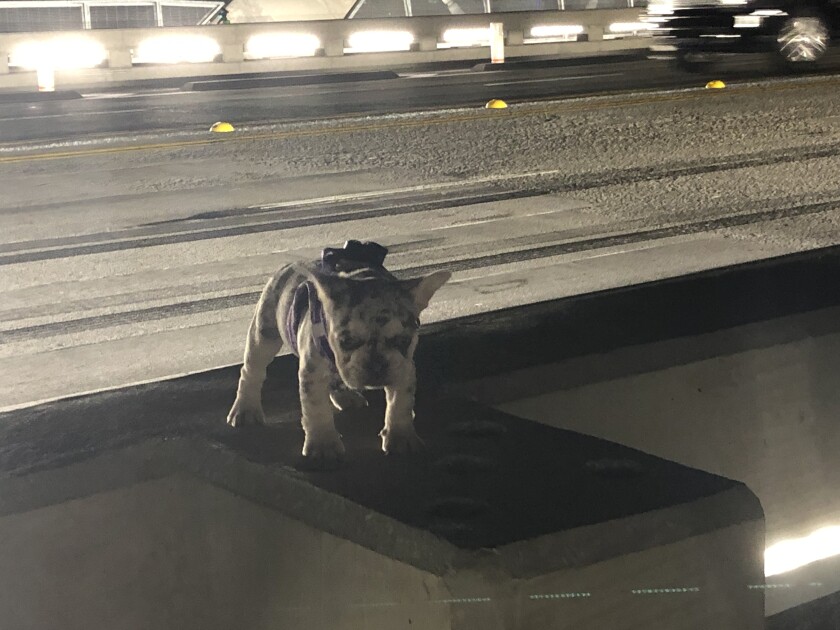
A Frenchie poses on the 6th Street Viaduct.
(Carolina A. Miranda / Los Angeles Times)
If the bridge has highlighted anything, it’s L.A.’s desperate need for public space. Not the private-public kind, such as L.A. Live and the Grove, which generally come with limited hours and hefty parking tabs. But clean, well-lit public areas — parks, plazas, promenades — where people can stroll.
The 6th Street bridge connects two park-poor neighborhoods. According to a 2016 parks assessment study funded by the L.A. County Board of Supervisors, the Arts District area has a “high” need for recreation areas, while Boyle Heights’ needs rank as “very high.” In the county, the average ratio of parkland is 3.3 acres per 1,000 people; Boyle Heights has less than a fifth of that.
Two parks are coming to the areas that surround the bridge’s touchdown spots on either side of the L.A. River, but they won’t be completed until 2024. In the meantime, the bridge serves as a photogenic gathering place — especially in the evenings when it is cool.
Tuesday, July 26, 8:20 p.m.
The sky is turning an inky blue but the western horizon still retains a sliver of orange. The bridge is bathed in red light and looks absolutely resplendent. It is most striking at night. I drive from the Eastside into the Arts District framed by the arches, which seem to echo the motion of my car.
Unfortunately, it’s all the time I’m getting on the viaduct. By the time I park and walk to the pedestrian ramp at 6th Street and Mateo, the bridge has been shut down.
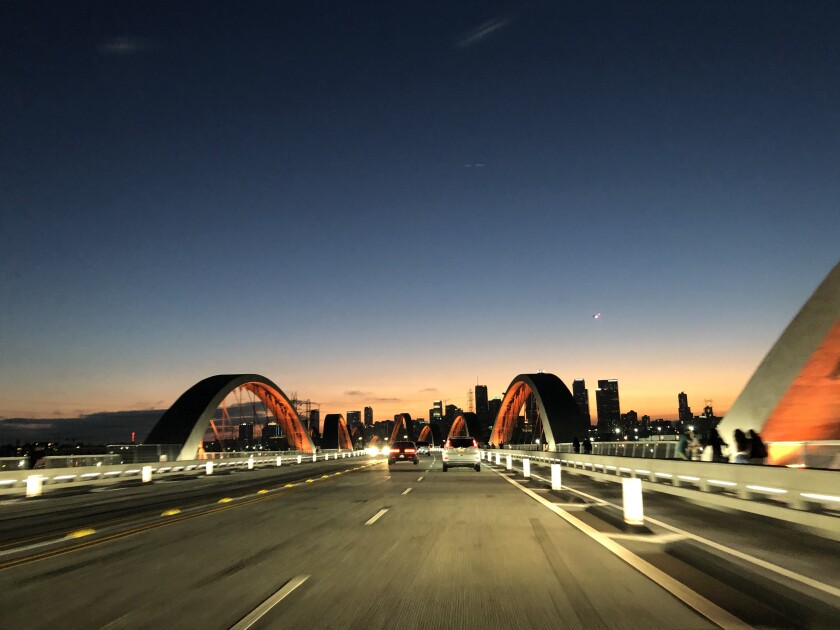
The 6th Street Viaduct at sunset on a cool Tuesday night.
(Carolina A. Miranda / Los Angeles Times)
I catch a young couple coming off the bridge. She’s a student based in South Pasadena, he’s an Air Force vet living in La Puente. He shows me a video he filmed of a large group of cyclists making their way across the span in a vehicular lane — presumably the cause of the shutdown. (The Times, in its report on the closure, was unable to confirm the exact cause.) Despite the shutdown, the couple remains impressed by the design. Says he: “It exceeds expectations.”
The shutdowns, of course, prompt the question of whether the bridge could be shut down in a more considered manner. Last week, The Times’ editorial board recommended excluding cars on a regular basis: “It’s an opportunity to rethink L.A. transportation infrastructure and public space.” It was a sentiment echoed by Tafarai Bayne, chief strategist at CicLAvia. “People are dying for public spaces,” he told LAist’s Ryan Fonseca. “They’re treating the bridge like a park — maybe we need more parks.”
Shutdowns are an interesting concept, though I’m wary of penalizing lowriders for the sins of drag racers.
Partial shutdowns might be a better idea. Keep the center lanes open for L.A. Metro’s 18 bus line, which travels between Koreatown and Montebello and crosses the bridge on its route. There is successful precedent for this type of design: In the early ’80s, the city of Denver revamped a mile-long stretch of downtown into the 16th Street Mall, replacing three lanes of traffic with broad pedestrian promenades and a pair of dedicated bus lanes. There are no cars.
It remains a distinctive part of the city and a pleasant place to hang out.
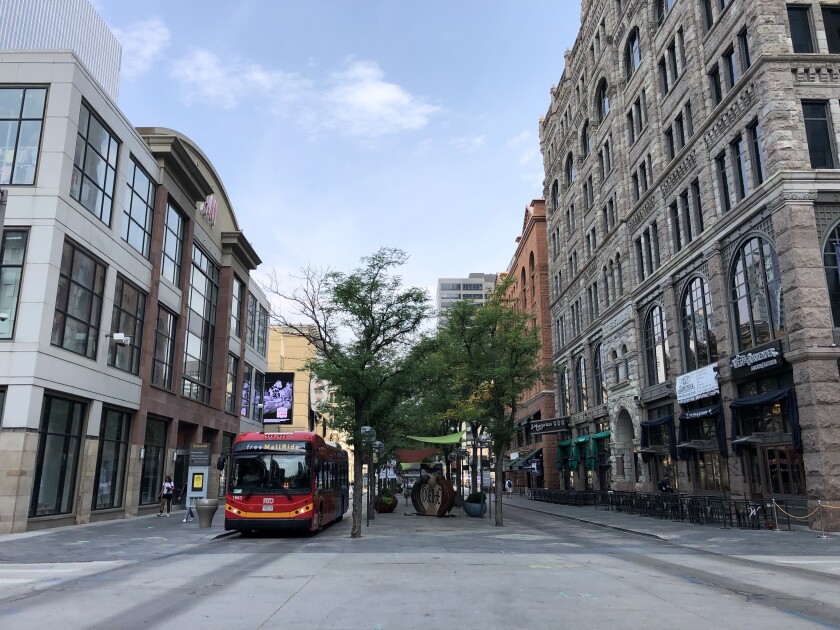
Denver’s 16th Street Mall, originally designed by I.M. Pei & Partners and Hanna/Olin (now OLIN), is closed off to all vehicular traffic — except for public buses.
(Carolina A. Miranda / Los Angeles Times)
Wednesday, July 27, 12:45 p.m.
It’s hot and hazy and the bridge looks like a bleached expanse. A couple of kids whiz by on scooters. Isolated pedestrians straggle across the sunbaked span.
I chat with Dulce Catzin, a schoolteacher who lives in Long Beach, who has come to visit the bridge with her husband, Oscar Catzin, also a teacher. They had avoided the bridge because of the media reports and are pleased to find it quiet. As a pedestrian, Dulce says she appreciates the concrete barrier between cyclists and pedestrians. “It’s safer,” she says. “Greenery would be good,” she adds, “and some shade.”
It’s 82 degrees and shade is at a premium. And the only place you’re going to find it at the noon hour is at the bridge’s midpoint — on the pedestrian ramp that boomerangs underneath the deck of the bridge and ultimately connects with a spiral ramp that leads down to Mission Road.
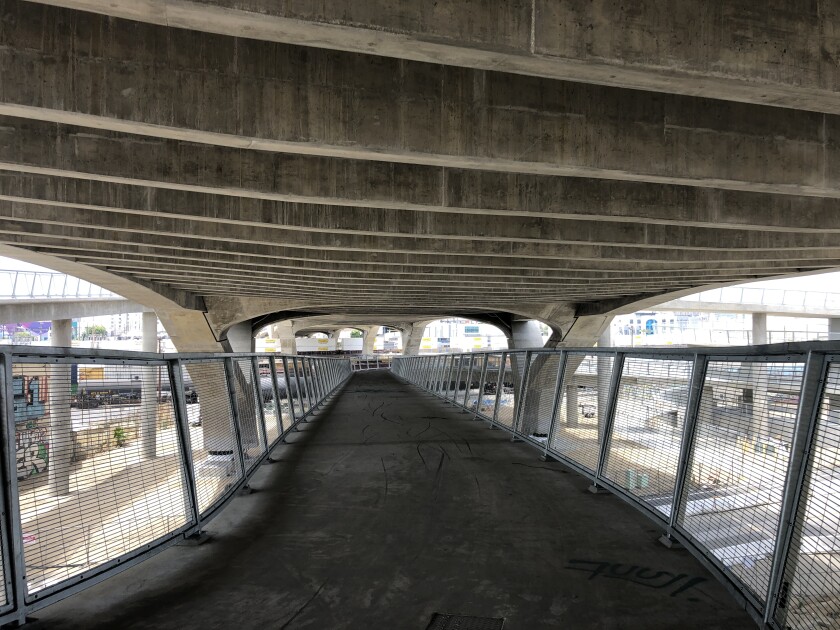
A pedestrian path boomerangs under the 6th Street Bridge’s deck to a ramp that leads to Mission Street.
(Carolina A. Miranda / Los Angeles Times)
As questions of shade equity loom large, the lack of shade structures marks one of the bridge’s major blind spots.
But the ramps offer a remarkable architectonic respite from the sun — as well as some remarkable framed views of the city, not to mention the bridge itself.
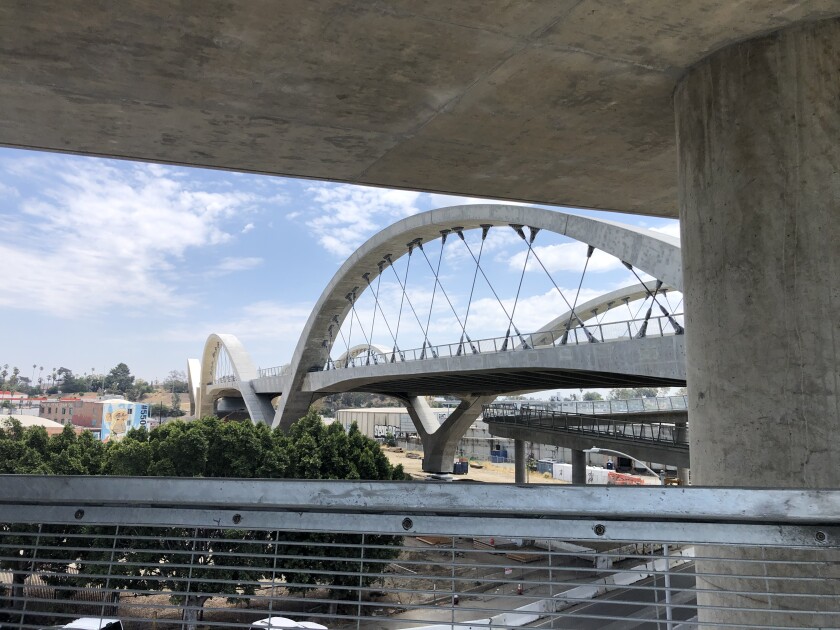
A view of the 6th Street Bridge from the spiral ramp that leads down to Mission Street on the Eastside.
(Carolina A. Miranda / Los Angeles Times)
Thursday, July 28, 5:20 p.m.
I start in Boyle Heights, where I catch sight of two sheriff’s deputies taking selfies in front of the bridge, then walk across to the Arts District.
One of the big criticisms of the bridge has been the design of the bike lanes, which aren’t protected by a concrete barrier similar to the one that protects pedestrians. In my initial report on the bridge I had wrongly assumed that the bike lane would be placed within the concrete barricades. (Sorry, cyclists!) Instead, they are separated from traffic only by rubber curbs and plastic bollards. As Alissa Walker points out in a recent story in Curbed, these do nothing to stop a car that is traveling at high speed.
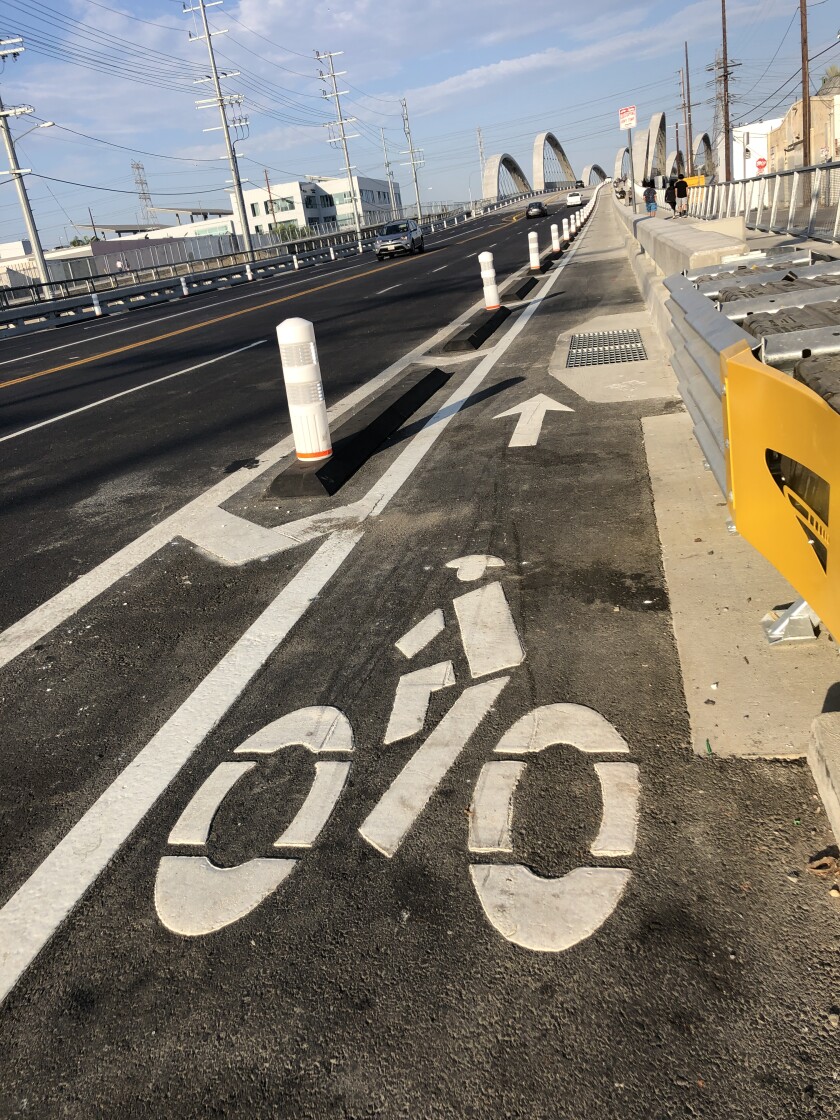
A view of one of the 6th Street Viaduct’s bike lanes from the Arts District — interrupted by a drain.
(Carolina A. Miranda / Los Angeles Times)
Soon after I install myself on the western end of the bridge, two cyclists pull up: Michael Perez and Kimiko Bennett, who rode in from Southeast L.A. They begin their trajectory in the bike lane but then turn around and ride into the pedestrian lane instead. They say they feel safer here. “It’s plastic,” says Perez, kicking at one of the bollards. “This is not even safe.”
Most cyclists, however, take to the bike lane without incident.
The bigger challenge is making it to the bike lane to begin with. There is no dedicated bike lane on 6th Street in the Arts District near the bridge, which means riders making the approach share a lane with traffic. At the corner of 6th and Mateo, there is also a bus stop to contend with. It’s chaotic, and it sends many riders onto the sidewalk.
On the eastern edge of the bridge it’s the same story: Bike lanes evaporate at the terminus, depositing riders back into traffic. A representative for City Councilman Kevin de León’s office told LAist last month that his office was working on a plan for bike lane improvements along Boyle Avenue. And a press representative for the Department of Transportation stated in an email to The Times that the department is “reviewing changes” that would extend bike lanes into Boyle Heights, but that “these options are still under review” and therefore there is “not a set timeline for implementation.”
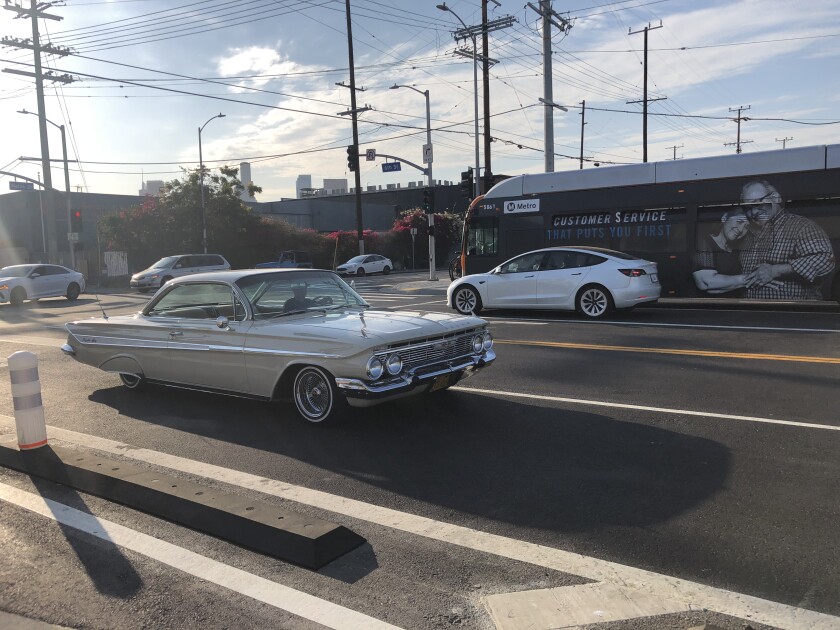
A lowrider takes to the 6th Street bridge.
(Carolina A. Miranda / Los Angeles Times)
I return to Boyle Heights via the 7th Street Bridge (completed in sections in 1910 and 1927) so that I can have a point of comparison.
The sidewalk is narrow — barely 5 feet wide — and I share it with a cyclist since there is no bike lane of any kind. Trucks roar past, whipping my hair and bathing me in grit. The hike back up to South Boyle Avenue requires navigating under a tangle of overpasses and freeway off-ramps.
Over the decades, planners have stuffed 135 acres of freeway into Boyle Heights. And this dour urban path stands as evidence that it will take much more than a single public work to stitch the neighborhood back together.
The 6th Street bridge may not be perfect, but it has gotten many things right. It’s a far more hospitable piece of infrastructure than the area’s status quo.

A view of the 6th Street Viaduct and the San Gabriel Mountains from the deck of the 7th Street Bridge.
(Carolina A. Miranda / Los Angeles Times)
Friday, July 29, 8:29 p.m.
It’s Friday night, and the bridge is hopping. Kids bounce around and 20-somethings strut their stuff as a tan sedan cruises past bearing a giant Mexican flag.
The occasional blip of a police siren encourages drivers to move along. But overall the bridge is relaxed.
I belly up to Tacos El Buen Gusto, a stand that’s been operating at Whittier Boulevard and South Boyle Avenue for more than a year. As I wait for my carne asada, a Critical Mass ride streams off the bridge. Cyclists, their rides covered in flashing lights, some bearing speakers pumping dance tunes, flood the intersection. The atmosphere is jubilant party.
Cyclists pour into Boyle Heights off the 6th Street Bridge during a Critical Mass ride
I ask the woman standing next to me if it’s her first time at the bridge. She tells me she’s been a regular since it opened.
“It’s beautiful,” she tells me in Spanish. “And it’s free!”
For all the latest Entertainment News Click Here
For the latest news and updates, follow us on Google News.
